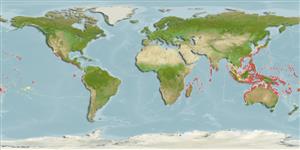Klassifizierung / Names
Namen | Synonyme | Catalog of Fishes (gen., sp.) | ITIS | CoL | WoRMS | Cloffa
Actinopterygii (Strahlenflosser) >
Perciformes (Perch-likes) >
Gobiidae (Gobies) > Gobiinae
Etymology: Bathygobius: Greek, bathys = deep + Latin, gobius = gudgeon (Ref. 45335).
Lebensraum / Klimazone / Range
Ökologie
; seewasser riff-verbunden. Tropical, preferred ?
Indo-West Pacific and Southeast Atlantic.
Size / Gewicht / Alter
Maturity: Lm ? range ? - ? cm
Max length : 5.0 cm TL Männchen/unbestimmt; (Ref. 2798)
Rückenflossenstacheln (insgesamt): 7; Rückenflossenweichstrahlen (insgesamt): 9; Afterflossenstacheln 1; Afterflossenweichstrahlen: 8. Males uniformly dark brown; fins dusky to black (Ref. 2798). Females light brown with crossbars on body; caudal base with dark bar; dorsal and caudal fins mottled, other fins clear (Ref. 2798); characterized further by having upper 5-6 pectoral rays partly free of membrane; rounded caudal fin; longitudinal scale series 28-32; predorsal scales 9-13, not reaching rear margin of preopercle; cheek, opercle, pectoral fin base and prepelvic area without scales; ctenoid body scales, becoming cycloid on head and anterior body (short distance anterior to first dorsal fin); depressed head, width greater than depth; depth of body 4.6-5.9 in SL (Ref. 90102).
Inhabits rock pools of intertidal zone, rocky shores and mangrove habitat (Ref. 90102).
Life cycle and mating behavior
Geschlechtsreife | Fortpflanzung | Ablaichen | Eier | Fecundity | Larven
Hoese, D.F., 1986. Gobiidae. p. 774-807. In M.M. Smith and P.C. Heemstra (eds.) Smiths' sea fishes. Springer-Verlag, Berlin. (Ref. 2798)
IUCN Rote Liste Status (Ref. 115185)
CITES (Ref. 94142)
Not Evaluated
Bedrohung für Menschen
Harmless
Nutzung durch Menschen
Mehr Information
NamenSynonymeMetabolismusRäuberÖkotoxikologieFortpflanzungGeschlechtsreifeAblaichenFecundityEierEientwicklung
ReferenzenAquakulturAquakultur ProfilZuchtlinienGenetikAllel-HäufigkeitenVererbbarkeitKrankheitenVerarbeitungMass conversion
PartnerBilderStamps, CoinsLauteCiguateraGeschwindigkeitSchwimmstilKiemenoberflächeOtolithsGehirngrößeSehfähigkeit
Tools
Zusatzinformationen
Download XML
Internet Quellen
Estimates of some properties based on models
Phylogenetic diversity index (Ref.
82805): PD
50 = 0.5000 [Uniqueness, from 0.5 = low to 2.0 = high].
Bayesian length-weight: a=0.00631 (0.00286 - 0.01390), b=3.08 (2.90 - 3.26), in cm Total Length, based on LWR estimates for this (Sub)family-body shape (Ref.
93245).
Trophic Level (Ref.
69278): 3.3 ±0.5 se; Based on size and trophs of closest relatives
Widerstandsfähigkeit (Ref.
69278): hoch, Verdopplung der Population dauert weniger als 15 Monate. (Preliminary K or Fecundity.).
Verwundbarkeit (Ref.
59153): Low vulnerability (11 of 100) .
